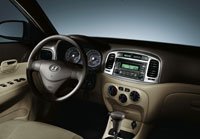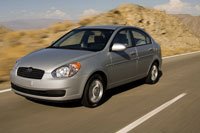 The Hyundai Accent has been completely redesigned from the ground up. The Accent four-door sedan was launched as an all-new 2006 model, while the three-door hatchback was introduced in the spring as a 2007 model.
The Hyundai Accent has been completely redesigned from the ground up. The Accent four-door sedan was launched as an all-new 2006 model, while the three-door hatchback was introduced in the spring as a 2007 model.Built on a more substantial platform and powered by a clean and sophisticated new 1.6-liter double overhead-cam engine, the new Accent models are larger and designed to offer more style, sophistication and content than before.
The competence of the new Accent indicates Hyundai's move upmarket has helped it design a better small car. The new Accent is considerably better and slightly larger than the old 2005 models. Indeed, the new Accent is a viable alternative to the newest subcompacts from Toyota, Honda and Nissan.
What's more, Hyundai includes safety features such as six airbags and antilock brakes as standard equipment, making the Accent and the Kia Rio among the least expensive cars on the market with these important safety features.
Based on our impressions, the new Accent should be considered alongside models from more established players.
Lineup
The 2006 Hyundai Accent is as a GLS four-door sedan with a choice of five-speed manual ($12,455) or four-speed automatic ($13,305). The 2007 Hyundai Accent three-door hatchback is available in GS and SE trim. A 110-hp, 1.6-liter four-cylinder engine powers all models. Power steering, a tilt steering wheel, and a 172-watt AM/FM/CD audio system with six speakers, and 14-inch steel wheels come standard.
Air conditioning, however, is optional ($800). The Premium Sport Package ($1,500) includes air conditioning, power windows, power door locks with remote keyless operation, and 15-inch alloy wheels with 195/55VR15 tires.
Safety features include front seatbelt pre-tensioners along with six airbags: dual frontal, front-seat side-impact and full-coverage side curtain. All models include ABS.
Walkaround
The all-new Hyundai Accent has a much more elegant look to it than the previous-generation model. It starts at the front with integrated 5-mph bumpers and large aerodynamic headlight enclosures that wrap around the front fenders. It has a high roofline with rubber trim running along each side and a windshield that blends into the front of the roof without any visible trim.
The back of the sedan roof sweeps toward the trailing edge of the trunk lid, giving it almost a coupe like appearance. Unlike many modern cars, it has a generous greenhouse with big windows and blacked out trim. This, coupled with a long wheelbase with relatively short overhangs, makes the sedan appear a tad bigger than it is in reality, which is not a bad thing.
Dare we say it but there's even a little bit of a hint of Volvo in its nose and maybe a dash of Honda in its rear three-quarter view. Overall it has a pretty, if somewhat ordinary, look to it that should not offend anyone. As part of Hyundai's plan, the Accent is purposely less sporty looking than its almost identical Kia Rio sibling.
Interior

Perhaps more than anything it's the interior of the new 2006 Hyundai Accent that has been improved over the 2005 models. For starters, there's a much better view out. The hip point in the driver's seat is two inches higher than in the old Accent, giving the driver a better view of the road. The new Accent cabin has a conservative two-tone interior color scheme reminiscent of larger cars and it's trimmed out quite nicely, helping it avoid the feeling of an econobox.
The dashboard wraps around to the door panels and the center stack is nicely integrated, with large, well positioned, climate control knobs. The big speedometer and tachometer are located in a nicely contoured instrument pod in front of the steering wheel. Smaller fuel and coolant temperature gauges are set inside, along with a small LCD readout for the odometer and trip meter as well as an indicator of the selected gear.
The seats are contoured and finished in a classy cloth material that feels high quality. The driver's seat is eight-way adjustable on all models.
The rear seat splits 60/40 for additional storage capacity. For better rearward visibility, the three rear-seat headrests slide down into the seatback when not needed, a design referred to as shingle-style. There's even a fold out center armrest with two cupholders in the rear.
Rear-seat leg room and headroom is not too bad unless the car is full of six-footers. Getting into the back seats was made easier by locating the rear wheels farther back, so the wheelwell does not intrude into the door opening as much.
Several nice touches prevent the Accent from feeling like a cheap econobox. Among them: dampened grab handles, a thick roof lining, center folding front and rear armrests, a tilt steering wheel, a micro roof-mounted antenna, driver and passenger side-illuminated vanity mirrors, cabin air filtration, remote trunk and fuel cap releases, and a windshield shade band. There are decent size pockets with a cup holder in each door. In addition there are other storage places and a big glovebox.
Driving Impressions

Nobody buying a Hyundai Accent will expect sizzling performance, yet the 1.6-liter four-cylinder engine is surprisingly snappy, even with the automatic. The Accent GLS automatic has no problem keeping up with traffic as long as you stomp on the gas pedal and it's more than happy cruising at speed on the freeway. We did not get a chance to try an Accent with a manual transmission but would expect it to be more fun to drive.
Hyundai's 1.6-liter four-cylinder is a modern, sophisticated engine with dual overhead camshafts and continuously variable valve timing. The DOHC and CVVT combination helps give the engine a very broad power band with high fuel efficiency and low emissions. City/Highway fuel economy is an EPA-estimated 32/35 mpg with the manual, 28/36 mpg with the automatic. The engine produces 110 horsepower at 6000 rpm and 106 pound-feet of torque at 4500 rpm.
The ride is on the soft side, softer than the Kia Rio, which gets the sportier settings. The power assisted rack-and-pinion steering provided reasonable feedback and the handling proved to be acceptable on some winding mountain roads near San Diego. Our Accent GLS automatic had the 15-inch alloy wheels with the sportier P195/55VR15 size tires. We did not try a base model with the skinny 14-inch tires and steel wheels, but suspect it will not handle as well.
The power assisted four-wheel disc brakes seemed to stop the car efficiently. The Accent comes standard with ABS and electronic brake-force distribution. ABS allows the driver to maintain steering control in an emergency braking situation by preventing wheel lockup. EBD improves stability in hard braking situations by balancing brake force front to rear.
Overall, the driving characteristics and performance make this a commuter car rather than a long distance cruiser.
Summary & Specifications
The Hyundai Accent is a competent subcompact car that's big inside and sprightly underway. It includes an impressive array of standard safety features and is certainly worthy of being considered alongside more expensive models from other manufacturers. A generous five-year/60,000-mile basic warranty with roadside assistance and a 10-year/100,000-mile powertrain warranty make the Accent a good deal for anyone who does not want to buy a used car and intends to keep the vehicle for an extended period of time. [source : automotive.com]
Post a Comment